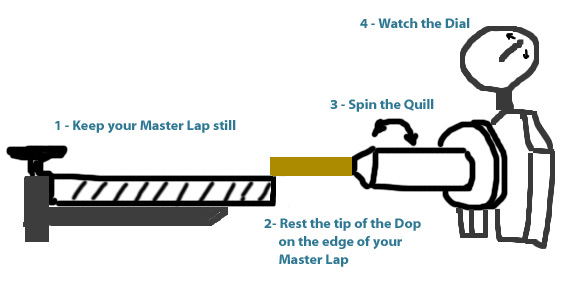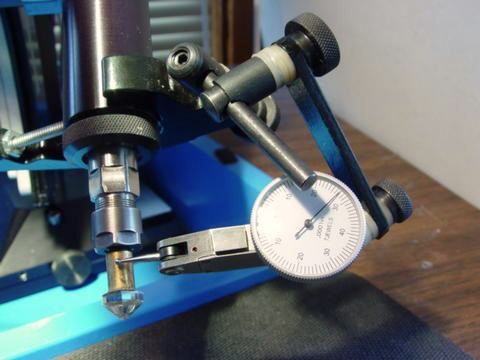Over the past year and a bit I’ve heard from several people who own Omni-E faceting machines who have trouble with their digital angle readout spontaneously changing degrees without rhyme or reason. I had not experienced that until recently and did not really know what to make of it. Now I’m unfortunately able to write about the problem first-hand.
Much has been made of how the Omni-E faceting machine, along with the new Ultra-Tec digital readout are the only two “true” digital faceting machines available. There’s been a lot of hype over using a digital encoder vs. a potentiometer (“pot”) due to a lot of fear, uncertainty and doubt sowed over the accuracy of the pot used.
My take on things: When I grab a ruler, I don’t care whether it’s made of plastic, wood or metal. I don’t care whether it’s clear or opaque, thick or thin. I don’t care whether it’s aluminum, brass or steel; I don’t care what sort of plastic it’s made from nor what tree it was grown on. Or the country it was manufactured in or the political affiliation of the persons who made it.
What I care about is:
- it’s accurate, meaning one unit of measure on the ruler is actually the distance it’s supposed to be
- it’s precise, meaning that I can easily differentiate between the units of measure without a lot of error
- it’s repeatable, meaning that when I use it to measure something at Time A it gives the same measurement at Time B
It is no good to have a beautifully-polished steel ruler with finely-engraved markings if the markings are not uniform. Why would I want a beautiful ruler that measures 1-1/2″ when in fact the measurement is 1-1/4″? Or one that has the inch marks on it random distances apart, so 1″ is in fact 3/4″ and 2″ is 3-1/2″? The unit markings are very precise and are repeatable at different times of the day, but are completely inaccurate. Beautiful garbage.
Likewise it’s not useful to have a ruler that has perfect unit markings but is elastic, so when pick it up it measures differently the first time than the next. Imagine your ruler with it’s impeccable unit markings measuring 1″ at 3:00 pm and then when you pick it up at 3:03 pm that “inch” is now 0.95″? It’s precise but not repeatable.
So the real question about whether a digital faceting machine angle readout is a good product or not comes down to whether:
- it’s accurately measuring the true angle of the dop and quill assembly
- it’s precise, showing you the 10ths or 100ths of degrees as desired
- it’s repeatable, so when you lift the dop to inspect the facet and lower it again, the read-out still shows the angle you set it to
—-
I’m one of those lucky individuals with an Omni-E digital encoder faceting machine that is precisely inaccurate.
Here’s what happened: during the birth of my daughter I left my Omni-E faceting machine switched on. I normally will leave it switched on up to 2 or 3 days in a row if I’m cutting stones. So far it hasn’t been a problem. However this time, due to the general chaos that surrounds a new baby entering the house, I didn’t get back to my Omni faceting machine for 12 days. I’d pass by it and note that it was still turned on and ready 40.0 degrees, but that’s about it. The machine remained physically undisturbed without being touched or moved all this time.
After day 8 or 9, I noticed that the angle readout changed from 40.0 to 40.1 degrees, all by itself. Strange. However I was too busy to come back and examine it. After day 11, the angle readout now showed 40.3 degrees! All without any human touch.
The temperature in our house is constant at 20C/68F, so I discount thermal changes. Besides, thermal changes should cancel themselves out as the metal expands and then contracts.
I turned the machine off for a day or so, thinking perhaps the electronics were getting overheated. Why this would happen in a well-designed system is beyond me, but the Omni faceting machine has not shown itself to be a well-designed system.
By lucky chance I found myself with an hour of free time, so I powered up my machine again on Day 14. I set the angle and proceeded to cut and polish the crown of a nice garnet. However imagine my surprise when I left the garnet with the last tier of facets left to polish. I got up and left the machine for about an hour, and when I came back the display had changed from 22.6 degrees to 20.3! It magically changed the angle readout by 2.3 degrees in an hour!
I wanted to know if the angle had indeed slipped and changed physically while I was away, so I left it as it was and proceeded to continue polishing. The angle was what it was locked in at as I had no problems polishing the remaining facets. But the angle readout continued to show 20.3 degrees instead of 22.6.
My experience here mirrors what the others have told me – through no actions of theirs, the angle readout changes randomly up or down. A couple have mentioned it appears to be related to things being turned on or off around the house – the furnace, wall lights and so on. In my case I have never experienced this and can’t correlate it to anything.
If indeed it’s related to other electrical items in the house switching on or off, then there is a serious design problem with the electronics power supply. It sounds to me like there is a missing or insufficient smoothing capacitor for the encoder power. Either that or the power supply is missing a RC filter to take out any transients that might be coming in.
So back, back to the first part of this discussion – the Omni-E faceting machine boasts having an extremely accurate digital encoder as opposed to a potentiometer. But due to sloppy design and construction the benefits of that encoder have been lost.
Do I care whether the Omni uses a digital encoder or a potentiometer? Nope. I just want my faceting machine to show me the angle I’m cutting accurately, precisely and repeatably. Which my Omni is not up to.













